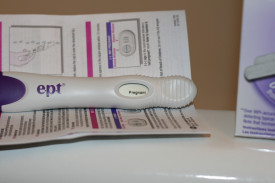Safe, effective birth control for men is long overdue. Consider a tale of two siblings:
When Mary hit middle school, she began having such painful periods that her father once called the paramedics, thinking she had a ruptured appendix. At age 14, she got a state-of-the-art hormonal IUD that cured her terrible monthly cramps. Over time the IUD not only would virtually eradicate her bleeding and pain, but would also provide top tier contraception through college with minimal side effects. Once Mary became sexually active, her annual pregnancy risk would be around 1 in 700. By contrast Mary’s college-age brother, who was relying on condoms (annual pregnancy risk 1 in 5), had to share the emotional and monetary burden of an unwanted pregnancy and abortion.
No parent wants a son to have to depend on the young women he dates to prevent a surprise pregnancy, but the options stink. As one mother of three boys put it,
Every day teens are having sexual relations, and the method of birth control is either left to the girl (most of which aren’t on anything because they don’t want their parents to know), condoms (which are horribly unreliable, especially in the hands of teens), or most often nothing. If parents were more involved and more teens had access to new methods of contraception… more kids would have the ability to make a future. Boys need that option as much as girls.
In the past 50 years, birth control for women has been refined to the point that there are now dozens of alternatives that are far safer than pregnancy, many of which have added benefits like reducing menstrual symptoms, acne, or even cancer risk. The array includes three kinds of long acting “fit and forget” contraceptives that are over 20 times better than the familiar Pill but allow a quick return to normal fertility. But, after all this time, men are still stuck choosing between two century-old choices, condoms and vasectomies.

Don’t get me wrong—condoms are far better than nothing. They are the best technology we have for reducing STDs! However, many people have a mistaken perception of how effective they are for actual pregnancy prevention. If everybody who relies on condoms could use them perfectly and with perfect consistency, only 2 couples in 100 would get pregnant each year via condom failure. But from a “human factors engineering” standpoint, condoms are dismal. In the real world where people fumble, forget, and wait too long to put them on or take them off, many couples depending on condoms end up pregnant. Condoms drop pregnancy rates from 85 percent (the rate for a sexually active couple using no contraception for one year) to 18 percent—a big improvement but still terrifying for someone whose plans and efforts could be blown apart by a ruptured rubber.
Men want better choices, and women want better choices for men, and parents want better choices for their sons. And yet, as Dr. John Amory at the University of Washington put it, “Everybody’s been saying, ‘within the next 5 years,’ for the last 30 years,” but no new method for men has made it to market.
We all, male and female alike, should be demanding better birth control for men. First off, there’s the fairness factor. Just like girls, young men should be able to pursue their dreams, confident that they won’t be derailed by a surprise pregnancy. In the retro movie, Walk on the Moon, a young mother, locked into a traditional working class lifestyle by teen pregnancy, feels drawn to the 1969 Summer of Love emerging around her. As she indulges her yearning for freedom and adventure (and Viggo Mortensen), her husband, who “did the right thing” when she first got pregnant, is confronted with his own losses, especially the college education foregone. “You think I wanted to fix TV’s?!” he asks.
Besides derailing individual lives, the fact that males can’t count on their contraception means we all get stuck living in old cultural scripts. For millennia our ancestors had no reliable means to manage their fertility. Given the power of the human sex drive, even abstinence commitments backed by a death penalty for sinners couldn’t be considered reliable! In other words, if our ancestors sought sex or intimacy—and we humans crave both—then children were a byproduct, wanted or not.

Consequently, throughout history children came into the world unplanned and mostly when parents would have chosen not to have another child. But to thrive, kids needed just as much care as they do today. In response, both culture and religion evolved messages to help ensure that such children were wanted and loved when they arrived. “Let go and let God,” some Christians say. “Que será, será.” “A baby is a blessing.” Still today, some fundamentalist sects make passive submission to pregnancy a sacred virtue, and in Western culture at large, go-with-the-flow childbearing is accepted and celebrated. This is true even though we now have good evidence that thoughtful family planning increases maternal and child health, prosperity, marital harmony, and the ability of young men and women to live fulfilling lives.
Until men have better control over their fertility, passive, go-with-the-flow attitudes about parenthood will be widespread. Relying on today’s contraceptive mix, nearly half the pregnancies in the United States are unintended. Many of these pregnancies end in abortion, but it is still normal for children to come into the world as unplanned babies. Most families adapt and adjust and welcome the unexpected as they have for centuries. To make such a big adjustment, it helps psychologically to be open in advance to this possibility. In other words, with their options limited to condoms, vasectomies, and reliance on girls and women, who have their own contraceptive difficulties (more on this later in the series), it is adaptive for men to cultivate a somewhat passive attitude about whether and when they bring offspring into the world.
But as the Serenity Prayer points out, there’s a difference between accepting the things we cannot change and changing the things we can. We can change the limited choices men have, and the next part of this series will present options that currently are in the pipeline. In an ideal world, each person would be empowered to manage his or her own fertility, which would make childbearing a mutual conversation and decision. When men can take charge of their fertility, cultural norms will change, and all of us, men, women, and children, will benefit.
Thanks to S. Minden for her expert editing eye on this series.


Comments are closed.